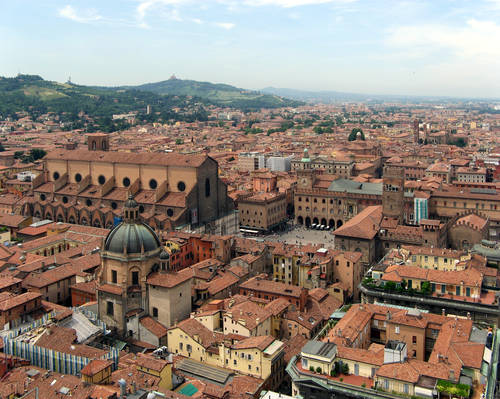Bologna
Museums, Artists, Monuments
We offer you a special itinerary to get to know Bologna with its history and its cultural protagonists.
Bologna is a very academic old town, renowned for its towers and long porches; it still preserves the fascination of a great town belonged to the past, rich of monuments and art pieces. Bologna has been frequently visited by romantic writers, and its art and cuisine are notorious. Today the University livens up the town, contributing to its cosmopolitan nature.

Bologna – Szs at the German language Wikipedia | 2006
Departure from Milan is set at 09:00 and the arrival at Bologna at 11 AM; the bus stop in Milan is at the crossroads between Paleocapa Street and Jacini Street, while, once in Bologna, the bus will stop by MAMbo – The Modern Art Museum of Bologna, where an art educator will welcome you.
MAMbo is the headquarter of the Institution Bologna Museums which deals with the Modern and Contemporary Art Area.
The Museum exhibition tells the evolution of Italian art from the end of WW2 to today, with a focus on research and the intent to trace new roads for art by following the most innovative and popping techniques of experimentation. The Museum is placed at the core of the cultural district named the Manifattura delle Arti, where an array of cultural realities come together. Such realities are the Cineteca of Bologna, the lab spaces owned by the Univerisity Departments DMS, the Faculty of Science Communication and numerous associations and art galleries. The Museum also hosts the renowned Morandi Museum: the widest and most relevant public collection devoted to Giorgio Morandi. The Collection comprehends 62 paintings, 18 watercolours, 92 drawings and 78 etchings. The Collection offers a unique occasion to know about the art of the Master from Bologna, and the path highlights the techniques and poetic nuances that make Morandi’s art so special.
Individual lunch (at own cost).
It is possible to have lunch inside the Museum, at the coffe shop “Ex Forno”.
The afternoon meeting is set at 14:30 under the porch of the MAMbo, where you will find the bus ready to take you to the Piazza Maggiore for a guided tour through the core of Bologna.
The Major Square is the main square of the town and it is surrounded by some of the most important buildings and monuments of the medieval city, such as Accursio Palace and Re Enzo Palace; the San Petronio Basilica, the Church of the people from Bologna, faces the square. As you walk around the centre, you will find out other important places, first among all: the Towers of Bologna, the Mercanzia Palace, Santo Stefano square and the Seven Churches, which is the real civic sanctuary and the cradle for the faith in the fathers. The origins of this last complex are quite unclear; on a hand, some people relate its birth to the Saint Patron of Bologna. Back to his times, he was the bishop of the town, and in 430 he wanted a complex to be built and later on to be divided into seven churches which, overall, would have stood as the symbolic reconstruction of the places of the Passion of Christ. Such version is supported by the old name of the complex: ‘Sacra Hierusalem’. On the other hand, other voices see the complex as built by Petronius, but on the ruins of a pagan temple which was built before, next to which a reproduction of the Saint Sepulchre of Jerusalem would have been later added. Furthermore, the buildings beside the sacello, which contains the remains of the protomartyrs of Bologna Vitale and Agricola found by Saint Ambrogio in 392, were built by the Benedictines between the 10th and the 13th century.
If you walk under the porches of Santo Stefano street, you will reach Fondazza Street n.36, where stands the Morandi House, the house where the artist lived and worked from 1910 to 1964. Here, furniture such as bottles, shells and studio models are placed in the same way Morandi used to see them in his atelier and broom closet. These pieces have kept their original status. The anteroom hosts the family furniture and part of the collection of ancient art which belonged to Morandi; the rest of the rooms has been thought and articulated in order to offer the visitor a path capable of telling the main moments in the life of the Master, from his family relations to his artistic education and encounters with the most notorious personalities from the movie and art world. This path entails an accurate selection of photographs, books, and various documents.
Way back to Milan is planned around 18:00.